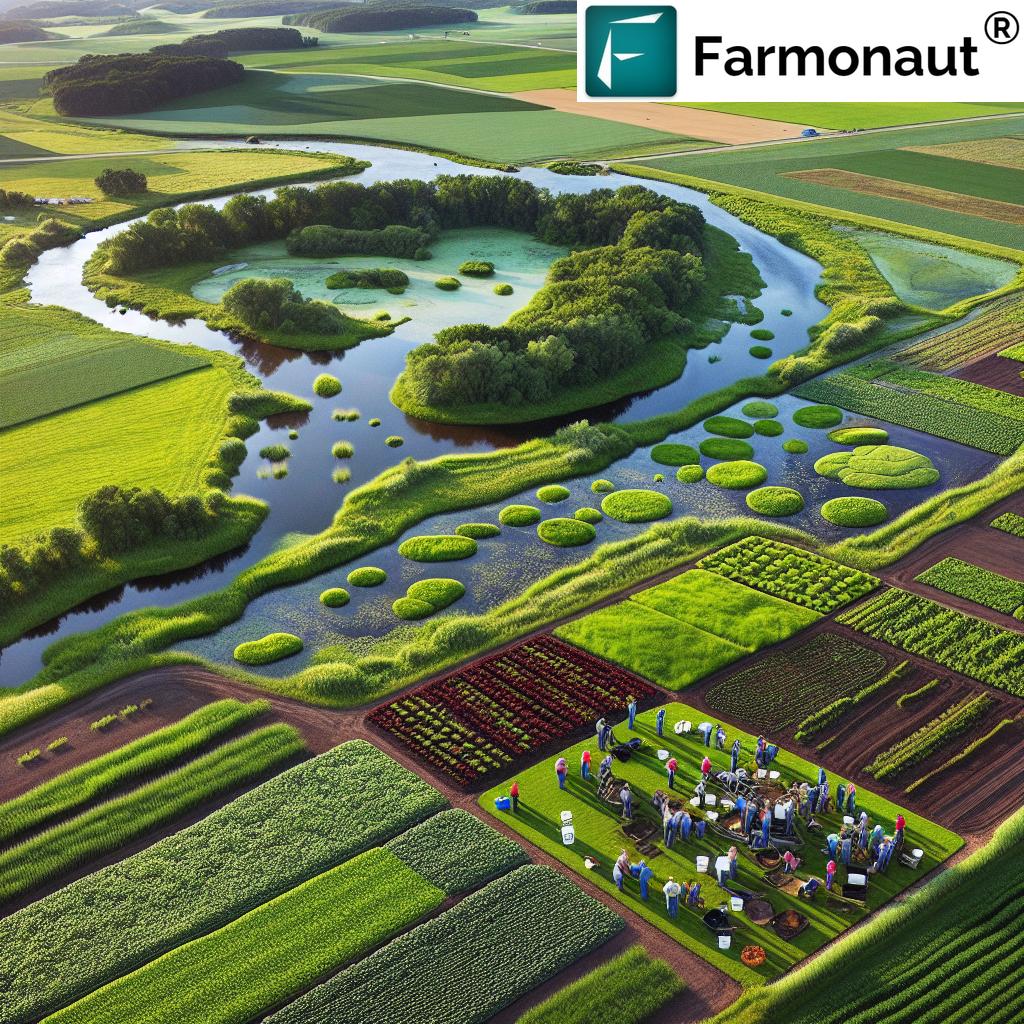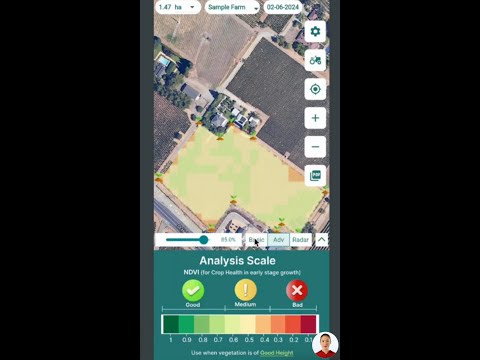Wisconsin Farmers Lead $1M Watershed Conservation Effort: Boosting Soil Health and Water Quality
“Wisconsin’s $1 million investment in watershed conservation supports 49 agricultural groups implementing sustainable farming practices.”
In the heart of America’s Dairyland, a groundbreaking initiative is taking root, one that promises to transform the landscape of agricultural conservation. We’re witnessing a remarkable partnership between Wisconsin farmers, state agencies, and environmental experts, all united in their commitment to preserving our precious natural resources. This collaborative effort, centered around watershed conservation and soil health improvement, is not just a local triumph but a beacon of hope for sustainable agriculture nationwide.
As we delve into the details of this $1 million investment in farmer-led watershed protection, we’ll explore how this program is empowering our agricultural stewards to lead the charge in environmental conservation. From innovative farming practices to cutting-edge research, we’ll uncover the multifaceted approach that’s making Wisconsin a frontrunner in balancing agricultural productivity with ecological responsibility.
The Producer-Led Watershed Protection Grant Program: A Game-Changer for Wisconsin Agriculture
At the core of Wisconsin’s watershed conservation efforts is the Producer-Led Watershed Protection Grant (PLWPG) Program. This initiative, spearheaded by the Wisconsin Department of Agriculture, Trade and Consumer Protection (DATCP), is a testament to the state’s commitment to sustainable farming practices and environmental stewardship.
The program’s structure is ingenious in its simplicity and powerful in its impact. By allocating funds directly to farmer-led groups, it ensures that those with the most intimate knowledge of the land – the farmers themselves – are at the forefront of conservation efforts. This approach not only leverages local expertise but also fosters a sense of ownership and pride among the agricultural community.

Let’s break down the key components of this groundbreaking program:
- Funding Allocation: The $1 million investment is distributed among 49 agricultural groups across Wisconsin.
- Focus Areas: The primary objectives are improving soil health and water quality in the state’s diverse watersheds.
- Collaborative Approach: Farmers work in tandem with conservation departments and agricultural experts to implement effective strategies.
- Innovative Techniques: The program encourages the adoption of sustainable farming practices, including the use of cover crops and advanced soil management techniques.
This initiative is not just about preserving our natural resources; it’s about fostering a new era of agricultural innovation. By providing farmers with the tools and knowledge to implement conservation practices, we’re seeing a ripple effect that extends far beyond individual farms.
The Impact of Farmer-Led Conservation Initiatives
The success of the PLWPG Program is perhaps best illustrated by the tangible results we’re seeing on the ground. One shining example is the Horse Creek Farmer-Led Watershed project, which has been in operation for over a decade.
“The Horse Creek Farmer-Led Watershed project has successfully reduced phosphorus levels and soil erosion through innovative conservation techniques.”
This veteran project showcases the long-term benefits of sustained conservation efforts:
- Phosphorus Reduction: Significant decreases in phosphorus levels in the watershed, contributing to improved water quality.
- Soil Erosion Control: Implementation of techniques that have markedly reduced soil erosion, preserving valuable topsoil.
- Cover Crop Adoption: Increased use of cover crops, which protect and enrich the soil during off-seasons.
- Water Infiltration Improvement: Enhanced soil structure leading to better water retention and reduced runoff.
These achievements are not isolated incidents but representative of the broader impact of the PLWPG Program across Wisconsin. The success of projects like Horse Creek serves as a model for other watersheds, inspiring farmers to adopt similar practices and join the conservation movement.
Expanding the Reach: New Groups and Continued Support
The latest round of funding under the PLWPG Program is particularly noteworthy for its dual approach of nurturing new initiatives while sustaining established projects. This year’s grant cycle welcomes three new groups into the fold, demonstrating the program’s commitment to expanding its reach and impact.
For farmers interested in leveraging technology to enhance their conservation efforts, Farmonaut’s web application offers advanced satellite-based farm management solutions. This tool can be particularly useful for monitoring crop health and optimizing resource use, aligning perfectly with the goals of the PLWPG Program.
The continued support for existing groups is equally crucial. It allows for the refinement of strategies, long-term data collection, and the establishment of best practices that can be shared across the state. This blend of new energy and seasoned experience creates a dynamic environment for innovation in agricultural conservation.
A Legacy of Conservation: The PLWPG Program’s Journey
Since its inception in 2015, the PLWPG Program has been a cornerstone of Wisconsin’s agricultural conservation efforts. Over the years, it has allocated more than $7.2 million to various groups across the state, funding a wide array of essential projects:
- Educational initiatives to spread awareness and knowledge about conservation practices
- On-farm demonstrations showcasing the effectiveness of sustainable techniques
- Research projects to develop new methods for soil and water conservation
- Incentive payments to encourage the adoption of conservation practices
- Field days that bring together farmers, experts, and community members
- Data collection efforts to track progress and inform future strategies
For those interested in the technical aspects of agricultural monitoring, Farmonaut’s API provides access to satellite and weather data that can be integrated into existing farm management systems. This can be an invaluable resource for groups looking to enhance their data collection and analysis capabilities.

Collaboration: The Key to Success
One of the most striking aspects of the PLWPG Program is its emphasis on collaboration. Each producer-led group is required to partner with entities such as county land conservation departments or the University of Wisconsin-Division of Extension. This requirement ensures that farmers have access to the latest scientific knowledge and technical expertise.
The collaborative approach extends beyond just partnering with academic and governmental bodies. It fosters a spirit of cooperation among farmers themselves, encouraging the sharing of knowledge and experiences. This peer-to-peer learning is invaluable, as it allows for the rapid dissemination of successful strategies and the collective solving of common challenges.
Financial Stewardship: Maximizing Impact
The PLWPG Program is designed not just to provide funding, but to ensure that the resources are used effectively and efficiently. To this end, there are several key stipulations regarding the use of grant funds:
- Funds cannot be used for real estate purchases, ensuring that the money goes directly into conservation efforts.
- Loans and equipment purchases are also prohibited, focusing the resources on actionable conservation practices.
- Lobbying activities are not eligible for funding, maintaining the program’s focus on practical, on-the-ground efforts.
- There’s a cap on funding for staff support, ensuring that the majority of resources are directed towards actual conservation work.
These restrictions reflect a commitment to financial stewardship, ensuring that every dollar invested in the program translates into tangible benefits for Wisconsin’s watersheds and agricultural lands.
The Future of Agricultural Conservation in Wisconsin
The success of the PLWPG Program has not gone unnoticed. Governor Tony Evers’ recent announcement of plans to increase funding to $2.5 million in the next biennium is a clear indication of the state’s continued commitment to agricultural conservation.
This proposed increase in funding opens up exciting possibilities for the future of watershed protection and soil health improvement in Wisconsin. It could mean:
- Expansion of the program to cover more watersheds across the state
- Increased support for existing groups to scale up their successful initiatives
- Investment in more advanced technologies for monitoring and implementing conservation practices
- Enhanced research capabilities to develop new, innovative approaches to sustainable agriculture
- Greater outreach and education efforts to involve more farmers and communities in conservation work
For farmers looking to stay at the forefront of agricultural technology, Farmonaut’s Android app and iOS app offer mobile solutions for farm management and monitoring, complementing the conservation efforts supported by the PLWPG Program.
Watershed Conservation Impact Comparison
| Watershed Name | Farmer Group Involved | Grant Amount Received (est.) | Primary Conservation Techniques | Phosphorus Reduction (est. %) | Soil Erosion Reduction (est. %) | Water Quality Improvement |
|---|---|---|---|---|---|---|
| Horse Creek | Horse Creek Farmer-Led Watershed | $40,000 | Cover crops, No-till farming | 30% | 40% | Significant |
| Milwaukee River | Milwaukee River Watershed Clean Farm Families | $35,000 | Buffer strips, Precision agriculture | 25% | 35% | Moderate |
| Red Cedar River | Farmers for Lake Country | $38,000 | Nutrient management, Wetland restoration | 28% | 32% | Substantial |
| Yahara River | Yahara Pride Farms | $42,000 | Low disturbance manure injection, Cover crops | 32% | 38% | Significant |
The Role of Technology in Agricultural Conservation
As we look to the future of agricultural conservation in Wisconsin, it’s clear that technology will play an increasingly important role. Advanced tools and techniques are enabling farmers to implement conservation practices with greater precision and effectiveness than ever before.
Satellite imagery, for instance, is revolutionizing the way we monitor crop health and soil conditions. Farmonaut’s API developer documentation provides insights into how this technology can be leveraged for agricultural applications, offering a glimpse into the future of precision farming.
Other technological advancements that are making a significant impact include:
- Precision agriculture tools for targeted application of fertilizers and pesticides
- Soil sensors that provide real-time data on moisture levels and nutrient content
- Drones for aerial mapping and monitoring of large agricultural areas
- AI and machine learning algorithms for predictive modeling of crop yields and environmental impacts
- GPS-guided equipment for more efficient and less disruptive field operations
These technologies not only enhance the effectiveness of conservation efforts but also contribute to the overall efficiency and productivity of farms. By adopting these tools, Wisconsin farmers are positioning themselves at the forefront of sustainable agriculture.
The Broader Impact: Beyond Wisconsin’s Borders
While the PLWPG Program is focused on Wisconsin, its impact extends far beyond the state’s borders. The success of this initiative serves as a model for other states and regions grappling with similar challenges in agricultural conservation.
The program demonstrates the power of:
- Farmer-led initiatives in driving meaningful environmental change
- Collaborative approaches that bring together diverse stakeholders
- Long-term investment in conservation practices
- Balancing agricultural productivity with environmental stewardship
As other states look to Wisconsin’s example, we may see a ripple effect of similar programs emerging across the country. This could lead to a nationwide movement towards more sustainable agricultural practices, with significant benefits for soil health, water quality, and overall ecosystem health.
Challenges and Opportunities Ahead
While the success of the PLWPG Program is undeniable, it’s important to acknowledge that challenges remain. Climate change, evolving agricultural markets, and changing consumer preferences all present ongoing challenges to the agricultural sector.
However, these challenges also present opportunities for innovation and growth. The PLWPG Program, with its emphasis on farmer-led initiatives and collaborative problem-solving, is well-positioned to address these challenges head-on.
Some areas of focus for the future might include:
- Developing climate-resilient farming practices
- Exploring new markets for sustainably produced agricultural products
- Enhancing public education and engagement around agricultural conservation
- Further integrating technology into conservation practices
- Expanding the program to reach more farmers and watersheds across the state
Conclusion: A Sustainable Future for Wisconsin Agriculture
The $1 million investment in Wisconsin’s watershed conservation efforts through the Producer-Led Watershed Protection Grant Program represents more than just a financial commitment. It’s a testament to the state’s dedication to sustainable agriculture, environmental stewardship, and the vital role of farmers in preserving our natural resources.
As we’ve explored throughout this article, the program’s success lies in its collaborative approach, empowering farmers to lead the charge in implementing innovative conservation practices. From reducing phosphorus levels and soil erosion to improving water quality and soil health, the impacts are tangible and far-reaching.
Looking ahead, the proposed increase in funding to $2.5 million in the next biennium signals a bright future for agricultural conservation in Wisconsin. This commitment, coupled with ongoing technological advancements and a growing awareness of the importance of sustainable farming practices, positions Wisconsin as a leader in balancing agricultural productivity with environmental responsibility.
As we continue to face challenges such as climate change and evolving agricultural markets, initiatives like the PLWPG Program will be crucial in ensuring the long-term health and viability of our farms, watersheds, and natural resources. By supporting our farmers in their role as environmental stewards, we’re not just protecting our land and water – we’re investing in a sustainable future for generations to come.
The success of Wisconsin’s watershed conservation efforts serves as an inspiring model for other states and regions, demonstrating the power of collaboration, innovation, and farmer-led initiatives in driving meaningful environmental change. As we move forward, let’s continue to support and celebrate the vital work of our farmers in preserving the health and beauty of Wisconsin’s natural landscape.
FAQ Section
Q1: What is the Producer-Led Watershed Protection Grant Program?
A1: The Producer-Led Watershed Protection Grant (PLWPG) Program is an initiative by the Wisconsin Department of Agriculture, Trade and Consumer Protection that provides funding to farmer-led groups for implementing conservation practices to improve soil health and water quality in their watersheds.
Q2: How much funding has been allocated to the program?
A2: Currently, $1 million has been invested in the program, supporting 49 agricultural groups. There are plans to increase funding to $2.5 million in the next biennium.
Q3: What types of conservation practices are supported by this program?
A3: The program supports various practices including cover crop planting, no-till farming, buffer strips, precision agriculture techniques, nutrient management, and wetland restoration, among others.
Q4: How successful has the program been?
A4: The program has shown significant success, with projects like the Horse Creek Farmer-Led Watershed demonstrating substantial reductions in phosphorus levels and soil erosion, and improvements in water quality.
Q5: Can any farmer in Wisconsin participate in this program?
A5: The program is designed for farmer-led groups rather than individual farmers. However, farmers can participate by joining or forming a producer-led group in their watershed area.
Earn With Farmonaut: Affiliate Program
Earn 20% recurring commission with Farmonaut’s affiliate program by sharing your promo code and helping farmers save 10%. Onboard 10 Elite farmers monthly to earn a minimum of $148,000 annually—start now and grow your income!







